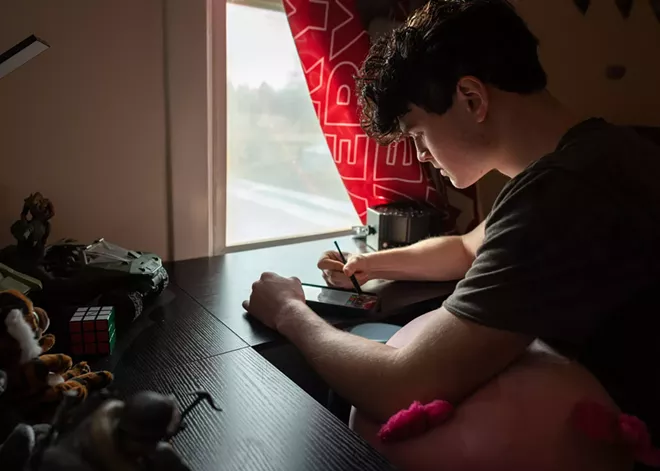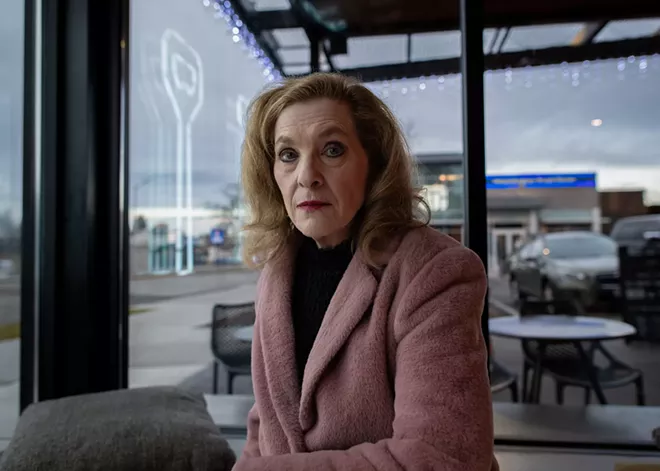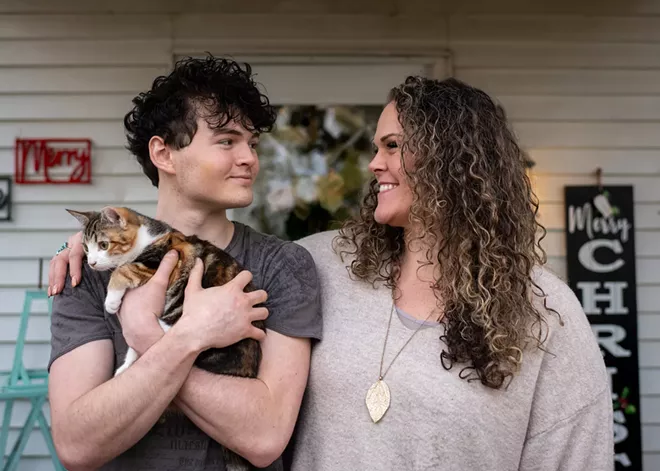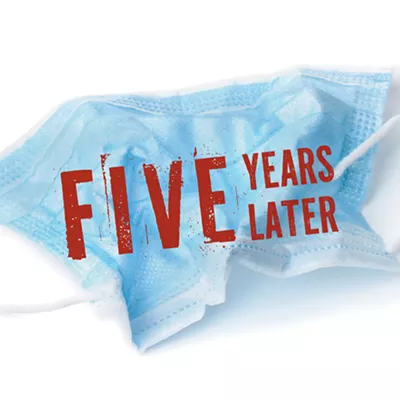
Early last year, Providence Sacred Heart Medical Center in Spokane painted a bleak picture of what would happen without its Psychiatric Center for Children and Adolescents.
As children's mental health needs escalate, teens in the area would lose access to lifesaving treatment. And other nearby facilities would struggle to fill the gap, Sacred Heart executives wrote in an application for a state Department of Commerce grant in February 2024, obtained by InvestigateWest in a records request.
"If this unit downsized or closed, this would cause even less access in an under-resourced area resulting in patients and families having to travel several hours for inpatient care," hospital leaders wrote.
Sacred Heart asked the state for $1.8 million to pay for facility upgrades to make the unit safer and "ensure that every child has access to high-quality, affordable and culturally competent mental health care."
The pitch worked. The state awarded Sacred Heart the full amount it requested.
But Sacred Heart turned the grant down in April. In September, it closed the Psychiatric Center for Children and Adolescents anyway.
The grant application, which said the youth psychiatric unit was operating at an annual $2 million loss, underscores why former employees and health care experts are critical of Sacred Heart and its parent network, Providence, in the wake of the decision. In interviews with InvestigateWest, they cast it as one more step by one of the nation's largest nonprofit hospital systems to improve its bottom line instead of meeting the needs of an escalating mental health crisis among children.
In the last decade, Sacred Heart repeatedly reduced services and long-term resources in the unit, according to internal emails, public records and interviews. Yet as Sacred Heart cuts youth services in Spokane, the Providence system is pouring more than $1 billion into a hospital expansion in Seattle that sees fewer Medicaid patients. And its executives are making millions.
"If you're complaining you're so broke, why are you able to pay these people so much?" said Dr. Cory Alexander, a child and adolescent psychiatrist who resigned from Sacred Heart around the time of the closure. She joined nursing staff and former patients at protests last summer decrying the closure and sounding the alarm about diminishing options for teens in crisis.
It's part of a nationwide trend of hospitals shutting down costly pediatric inpatient services, even in nonprofit systems that receive billions in annual tax breaks in exchange for providing charity care and meeting community needs. Hospitals closed nearly 30% of pediatric inpatient units from 2008 to 2022, while adult inpatient units shrank by only 4%, an American Medical Association study found.
Susan Stacey, CEO of Sacred Heart, downplayed the role of finances in her decision to close the inpatient unit. She said she moved forward only after careful consideration of stakeholder feedback, and grappling with staffing challenges that reduced the number of available beds over the years.
"We do not go into these decisions lightly at all," she said. "We had been struggling with physician recruitment for the last few years. This had been an ongoing struggle."
Today, Stacey minimizes the dire impacts of the closure that the hospital predicted in its grant application back in February. Then, Sacred Heart executives said nearby facilities including Inland Northwest Behavioral Health, a for-profit center that treats youth, were "nearly always at capacity." Now, the hospital says Inland Northwest Behavioral Health is ready to meet the demand for adolescent inpatient treatment.
But families say Sacred Heart got it right the first time: Kids with acute mental health needs will be stuck in the emergency room while they wait for treatment somewhere else.
Jessica Turley went to Inland Northwest Behavioral Health for help in the fall of 2023 when her son threatened to harm himself. But staff refused to admit the teenager after he said he had thoughts about hurting others. Months later, Sacred Heart admitted him when he again became suicidal.
She worries that other children will also face longer waits, farther drives and fewer options for care.
"If anything, we need more places like that, not less," said Turley. "It's so needed right now, and I credit them with saving his life. If something were to happen, Inland has already said no, so that's not an option."

A STEADY DECLINE
Current and former employees of Sacred Heart told InvestigateWest that they were hardly surprised when hospital executives informed them that the 40-year-old youth psychiatric center would close."We had suspected they were moving in that direction for quite a while," said Kaili Timperley, a nurse who worked in the unit from August 2022 until it closed.
Staff recounted the dwindling capacity of beds within the unit, declining morale and rising concerns about safety. Some who remained there until the end said they felt overworked and unable to provide the quality of care that they wanted to, due to the hospital's failure to hire and retain highly trained providers such as psychiatrists and nurse practitioners. Leadership promised new plans to plug the holes.
For years, hospital leaders indicated that finances played a role in the decisions it made for the unit. In 2022, for example, when Sacred Heart terminated all of its psychiatrists, its medical director described the savings as "a significant chunk" that would help sustain the hospital's mental health care services, which he called "an imperative need."
The hospital said it would hire back four doctors as faculty within the hospital's psychiatry residency and a child psychiatry fellowship. Residents and fellows would work in the adult and youth inpatient units under supervision of the licensed psychiatrists, and newly hired nurse practitioners would take over other work.
Sacred Heart's decision did not play out as it said it would, however. None of the doctors returned to fill the redesigned positions, according to staff, and the hospital wound up relying on more expensive traveling doctors to fill the gaps. The number of fellows dwindled, and the psychiatry residents were not required to do rotations in the children's unit, leaving more staffing holes. Multiple nurse practitioners who were hired left within a year or two.
Today, hospital leaders minimize the role that finances played in its staffing shortages, contradicting what they said in 2022.
In a recent interview with InvestigateWest, Stacey said the decision to terminate psychiatrists was not made to save money. Instead, she described it as a move "to fully invest in our psychiatric faculty and residents ... with the goal of increasing the number of psychiatrists that we were helping to produce in the community."
All four staff members who spoke with InvestigateWest said Sacred Heart's own decisions had contributed to its inability to keep the psychiatric unit staffed since then. Compared to other local hospitals and inpatient units, Sacred Heart's salaries were not competitive enough to attract child and adolescent psychiatrists who otherwise showed interest, they said.
Infrastructure posed other problems: The unit was becoming dilapidated after 40 years. When Sacred Heart leaders applied for the Department of Commerce Closure Prevention grant, they cited safety concerns that they said they had little ability to address without help.
That included replacing old plumbing fixtures with versions resistant to self-harm attempts, a critical need in a psychiatric unit. They also planned to replace windows, countertops and flooring, and reinforce walls to prevent damage from thrown items or punches.
"Once the space is renovated, Providence is committed to maintenance and upkeep to ensure it can be utilized for another 30-40 years," the application stated.
Now, however, a spokesperson said the staffing challenges posed a bigger threat to the unit's future than its building needs. Accepting the $1.8 million from the state would have required a commitment to stay open for another 10 years.
"Even if we used the funding for physical updates to the unit, we still would not have the adequate staff," said Beth Hegde, spokesperson for the hospital.
Though the unit was accepting fewer children, staff grew more concerned about those patients' safety and their own.
Alexander, the psychiatrist hired in 2023 to work in youth and adolescent outpatient programs, was frequently asked to work in the inpatient unit due to staffing shortages. She said she repeatedly had to push back against proposed moves and patient admissions that she felt the staff were not prepared to handle.
"We didn't have the backing and support," she said. "When we said, 'We're concerned about staffing, we don't know if we can handle this,' we were ignored."
Often, the most complicated cases involved children in crisis who are also profoundly impacted by autism or developmental disabilities. Sacred Heart's treatment of these teens was a double-edged sword: While the unit was frequently the only place that accepted such children for treatment, the lack of resources, personnel and training made their care more difficult on workers and less effective for the children, staff said.
Other challenges were tied up in Washington's statewide shortage of long-term psychiatric resources. While the hospital unit aimed to stabilize kids in crisis on a short-term basis, many children were there longer, simply because they had no other place to go.
Jack Johansen was one of those kids. He entered the Psychiatric Center for Children and Adolescents in September 2022 after experiencing suicidal ideation and catatonic episodes. But with no safe housing option to return to, he stayed in the unit for around a year. He went to school online, attended group and individual counseling, and participated in other therapeutic activities such as yoga.
Johansen, now 18, knew the unit wasn't designed to care for him for so long. Even so, he said that access to inpatient care was critical to his ongoing recovery and health.
"They were willing to do more for these kids than any other place would," Johansen said. "They all made it so clear to me that they wanted me to go back into a circumstance where I could be successful, so that I wouldn't have to come back."

NATIONWIDE CLOSURES
When hospitals face financial strain, children's mental health services are among the first to go — in for-profit and nonprofit systems alike.Seven months before Sacred Heart laid off its psychiatrists in 2022, Washington's largest private psychiatric hospital, Fairfax Behavioral Health, shuttered its adolescent inpatient unit after state health officials discovered unsafe conditions and halted new youth admissions.
The following year, in 2023, Cadence Child and Adolescent Therapy closed without explanation in another Seattle suburb, further depleting outpatient mental health services.
Those closures came as the U.S. Surgeon General warned of alarming increases in anxiety, depression, hopelessness, suicidal thoughts and mental illness among youth compounded by the pandemic. In May 2024, the nation's top physician called the youth mental health crisis the "defining public health issue of our time."
Since at least 2012, increased access to mental health care has been a critical need in Eastern Washington too, according to Sacred Heart's community needs assessments.
Nonprofit hospitals, including those under the Providence umbrella, receive federal and state tax breaks in exchange for charitable work in their communities. But federal and state laws dictating that spending are vague. The Internal Revenue Service doesn't define community benefits but gives examples including using surplus funds to improve facilities, care and medical training. That leaves hospitals to decide how much to give back and communities shortchanged, said Dr. Vikas Saini, president of the Lown Institute, which advocates for ethical health care.
Sacred Heart's most recent needs report stated that "the rate of suicide attempts by Spokane County youth has been sharply increasing since 2015." Yet there is no mention of its inpatient psychiatric unit in the hospital's community improvement plan.
Providence is one of the largest nonprofit hospital systems in the country, with 51 hospitals across the West. The system spends $1 billion less annually on community investments than it receives in tax exemptions, a disparity that is the second-worst in the country, according to a 2024 Lown Institute analysis. In 2023, Providence spent $2.1 billion on community benefit, with the largest portion going to unpaid costs of Medicaid and other government programs, according to its annual report.
In 2017, Providence Hospital, which was operated by Ascension Health, another large Catholic hospital system, began cutting children's behavioral health services in an underserved Washington, D.C., community. Within two years, the entire hospital was shut down. In 2020, Trinity Health of New England shut down an inpatient behavioral health center in Massachusetts for adults and youth, attributing the closure to a provider shortage. And in 2023, Waco, Texas, lost a children's behavioral health center run by Ascension Healthcare, which cited an inability to make building renovations needed to keep patients safe amid a rising demand for care.
A shortage of beds has forced families to seek help hours away or even across state lines. Some never get the help they need. Access to care is more elusive for low-income families or those in rural areas, said Dr. Jennifer Hoffmann, who oversaw a national study that found children's inpatient services are not keeping up with the need for care.
Even before Sacred Heart closed its doors this fall, there weren't enough psychiatric beds to care for Washington youth, according to the study published in JAMA Pediatrics.
Yet as child advocates and families in Eastern Washington push for more local treatment options, Providence is pouring resources into a hospital expansion across the state: a new $1.3 billion Seattle tower that includes emergency room suites designed for mental health patients. No psychiatric inpatient beds for children or adults are mentioned in the plans. Saini said these high-tech, state-of-the-art facilities often pop up in affluent cities where private insurance pours in and covers the shortfalls of government insurance.
In 2020, Washington had only seven pediatric behavioral health beds per 100,000 kids, researchers found. That's well below the national average of 19 beds, ranking Washington 43rd nationally.
Difficulties recruiting and retaining psychiatrists willing to work the grueling, on-call shifts left Sacred Heart unable to care for youth who need round-the-clock care, said Stacey, the Sacred Heart CEO. The best option: close the unit and increase investments in day treatments.
"Do we get ahead of the mental health crisis instead of fixing the hospitalization side?" she said. "Let's address it upstream so we prevent someone from getting to the point where they need a hospitalization."
Hoffmann, a pediatric emergency physician, said a growing number of kids in crisis are flooding emergency rooms as investments shift to outpatient care.
"I agree that more investment is needed in outpatient mental health care, but not at the expense of children today who have real mental health needs that require intensive services," Hoffmann said. "Some children have an acute safety risk either to harm themselves or others, and they're getting stuck in emergency rooms for days or weeks waiting for a bed without receiving the psychiatric treatment they need."
LITTLE RELIEF FROM THE STATE
In many ways, Washington hospitals face particular difficulties in sustaining a unit like Sacred Heart's.Hospitals rely on Medicaid reimbursement to cover many patient costs, including the exorbitant expense of providing inpatient psychiatric care for children. More than 25% of Sacred Heart patients were covered by Medicaid in 2023, according to its most recent annual report. But hospitals typically get back about $0.75 to $0.85 for every dollar they spend.
In recent years, research has shown Washington hospitals receive even less for mental health services. One comparison of 2022 Medicaid rates revealed Washington's reimbursement for mental health services was below the national average, with only 12 states ranking lower. And only two states pay lower reimbursement rates for specialists like child psychiatrists when compared to other government health care subsidies, according to the Washington State Medical Association.
Despite significant tax benefits, 85% of Washington hospitals lost money in 2023, according to financial reports submitted to the State Hospital Association. Sacred Heart finance reports show operating losses dating back to 2016. Another financial hit came last February when the Washington attorney general ordered Providence to forgive $137 million in medical debt and refund another $20 million for deceiving patients who likely qualified for free or discounted care, which is part of the charitable hospital's community obligations. It was the largest penalty of its kind in the country.
The Providence system is reporting hundreds of millions of dollars in net income in the first half of 2024, its first profitable quarters in two years. Amid profit losses and criticism about its deceptive billing practices, nonprofit executives made millions. Providence's north division chief received $6.1 million in compensation and benefits while its chief executive and administrative officers were paid more than $5 million each, according to 2023 tax reports. Providence spokespeople declined to answer questions from InvestigateWest about its investment in Seattle, finances and executive pay.
"For-profit, nonprofit, it doesn't matter," Saini said. "They're all operating like for-profits now."
Recognizing providers' need for more support, state legislators have increased Washington's Medicaid rates in recent years. In 2023, behavioral health care providers of all kinds received an increase of 15%. Inpatient units such as Sacred Heart's were excluded — but only because they received a boost to the daily rate of pay for each patient. At Sacred Heart, Washington went from paying $1,087 a day per patient in 2023 to $2,001 in 2024.
In the wake of such increases, Eric Lewis, chief financial officer for the Washington State Hospital Association, said Washington's Medicaid rates have moved closer to the national average.
"But average is not very good," he said.
Rep. Lauren Davis, D-Shoreline, sits on the state's Children and Youth Behavioral Health Workgroup. She said health care providers have primarily raised concerns with the workgroup about staff shortages, which are tied to the reimbursement rates.
"Rates are a factor with just about everything, honestly," she said. "If you back into what is driving the workforce crisis, ultimately, part of that is rates, because you can't pay staff adequately to recruit or retain. So they're interrelated."
WHERE SPOKANE GOES FROM HERE
Sacred Heart leaders say the hospitals' outpatient programs will continue to support youth. For those who need inpatient care, they point to a private psychiatric hospital just down the road with 27 beds.Inland Northwest Behavioral Health opened its adolescent wing in 2020, with funding help from Providence. Jamie Valdez, business development director for the private psychiatric hospital, said the adolescent unit serves about 20 to 22 youth from in and around Spokane each day.
"I think we've been absolutely prepared for this, and it's been a smooth transition," she said.
In some ways, the private unit is like Sacred Heart's: Youth in crisis who are at risk of harming themselves can generally walk in and receive stabilizing care for several days. Inland Northwest Behavioral Health also offers outpatient services to youth.
But in other ways, the private psychiatric facility is less accessible. Teens with autism, chronic medical conditions, serious mental illness or violent tendencies are sometimes turned away, which leaves many of them cycling in and out of local ERs.
That's what happened to the kids at Youth Educational Services, a group home for youth with disabilities and behavioral challenges in Spokane.
There are no mental health providers at the group home, so it's not unusual for residents to seek care at Sacred Heart, said Jeremy Maginnis, an administrator who oversees the home. But the quality of care and length of stay has diminished since the hospital began dwindling its inpatient resources, he said, resulting in more visits to the ER.
"In the ER department they're trying to get people in and out as quick as possible, and sometimes the kids are barely stabilized before they call us to come get them," Maginnis said. "They may meet the criteria for discharge, but they're not necessarily stabilized to come back into the least restrictive environment. But we can't refuse to pick them up, so we do, and then they end up back in the ER again."
Maginnis said Inland Northwest Behavioral Health has refused to treat some of the home's residents who struggle with psychosis. They had previously been admitted to Sacred Heart's shuttered unit, but now have nowhere to go, he said.
Amid its overall shortage of mental health resources, Washington leaders are trying to balance prioritizing outpatient and inpatient investments. But mental health experts raise alarms about cutting intensive inpatient resources in order to increase outpatient services.
State leaders who spoke to InvestigateWest, including state Sen. Marcus Riccelli, D-Spokane, said they were reluctant to see that trade-off, too.
"It definitely feels like moving in the wrong direction," Riccelli said. ♦
InvestigateWest is part of the Mental Health Parity Collaborative, a group of newsrooms that are covering stories on mental health care access and inequities in the U.S. The partners on this project include The Carter Center and newsrooms in select states across the country.




















